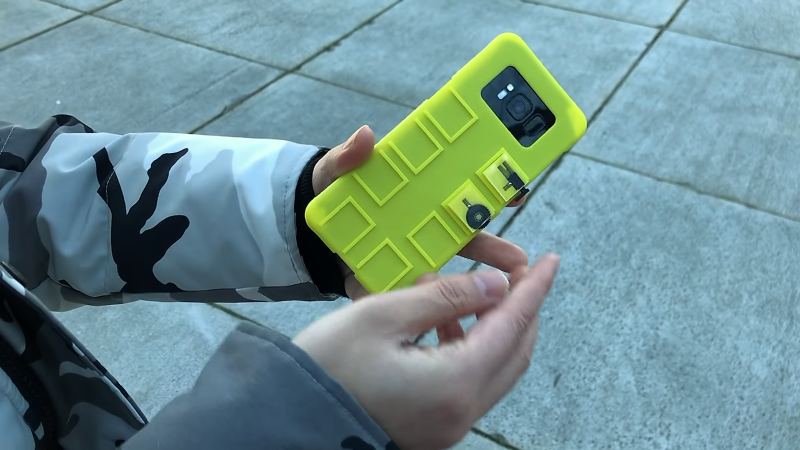The first LED digital wristwatches hit the market in the 1970s. They required a button push to turn the display on, prompting one comedian to quip that giving one to a one-armed man would be in poor taste. While the UIs of watches and other wearables have improved since then, smartphones still present some usability challenges. Some of the touch screen gestures needed to operate a phone, like pinching, are nigh impossible when one-handing the phone, and woe unto those with stubby thumbs when trying to take a selfie.
You’d think that the fleet of sensors and the raw computing power on board would afford better ways to control phones. And you’d be right, if the modular mechanical input widgets described in a paper from Columbia University catch on. Dubbed “Vidgets” by [Chang Xiao] et al, the haptic devices are designed to create characteristic acceleration profiles on a phone’s inertial measurement unit (IMU) when actuated. Vidgets take various forms, from push buttons to scroll wheels, each of a similar size and shape and designed to dock into one of eight positions on the back of a 3D-printed phone case. Once trained, the algorithm watches for the acceleration signature caused by actuating a Vidget, and sends commands to the phone to mimic the corresponding gestures. The video below demonstrates a couple of use cases, of which the virtual saxophone is our favorite.
This is really clever stuff, and ventures deep into “Why didn’t I think of that?” territory. Need to get ahead of the curve on IMUs to capitalize on what they can do? You could start with [Al Williams]’ primer on micro-electromechanical systems, or MEMS.
Thanks to [Itay Ramot] for the tip, [via Gizmodo]
















this is very cool, at fist I thought they where using NFC to connect to the phone but this idea is brilliant. I could see it in a commercial product
the hardware looks good but it all about the software
Sony jog dial anyone?
Yes! Loved that on the Clie.
genius. Lenience the idea to someone fast.
Freekn awesome!
I bet the whole point was to make the saxophone, that was brilliant!
Would have been nice if you had named the comedian.
Would have if I remembered. The neurons that stored that bit of information were long ago recycled for more important use, like the lyrics to every song I’ve heard since then.
Just me mumbling.
New smartphones has:
– no borders around display
– no buttons
– no connectors
All for the sake of adding external ugly cases with buttons and connectors.
It’s not just you…
Having physical widgets that can be moved around is somewhat compelling though, don’t you think?
> moved around
You mean fall out and get lost, right? :)
If you are totally inept, yes.
nah, new smartphones have all those things for the sake of selling more smartphones. How can you sell someone a new phone after a year or two if you dont change the feature set and then use pervasive advertising to convince people that those new features are what they need.
The problem is that advertising works all to well for the majority of people as it convinces them to ignore critical thought for the sake of “shiny!” or the need to fit in with the “cool group”. We allow the advertisers to have such a pervasive influence into our society that it is sickening, free markets will never be free as long as there is advertising.
My phone is one of those with curved edges, I’m not sure why I can’t already do these things with that. There was so much promised!
I definitely don’t want a button that calls Paul though.
“There was so much promised!” My story with my Moto Z.
“There was so much promised!” My story with my Nvidia Shield.
Same for my LG G5.
My Moto X2 and Z2 phones had a very neat feature – certain motions of the device would launch particular functions, when the phone was off (or locked/sleeping/whatever.) For example, while holding the phone normally, twisting your wrist back and forth twice quickly would start the camera right away for quick pictures. The Z2 allowed a karate chop motion to toggle the light on and off, again no fumbling around with turning it on, clicking stuff, entering a code or pattern and eventually turning the flashlight on.
I would really like to learn how to write an app that could run in the background on my Samsung and perform similar by monitoring the imu and launching particular functions when certain patterns are detected. The key is that this work even when the phone is sleeping. For example, if I hold the thing normally and tap on the (blank) screen a few times, I’d like my calculator of choice to pop up…
Rubbing a finger along the edge of a mobile in two different directions actually gives two distinct acceleration patterns. One could use this to replace the volume rocker.
This only took me two days of searching and thinking to find: https://hackaday.com/2012/10/11/acoustic-barcodes-deliver-data-with-a-fingernail-and-microphone/
Granted a little turny-wheel with a clicker is probably smaller.
Food for thought.